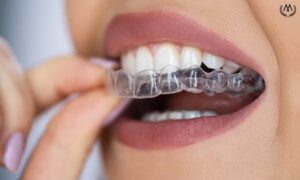Clear aligner therapy offers numerous advantages in terms of aesthetics and comfort. However, it may not be suitable for all orthodontic issues. MK Aligners, like other clear aligners, have limitations and restrictions for specific conditions. Here are some situations where clear aligner therapy may not be appropriate:
1. Complex Dental Crowding
Description: Clear aligner therapy is typically effective for mild to moderate dental crowding. However, severe crowding, where teeth are significantly displaced, may not be suitable for this treatment method.
Reason: Such conditions may require substantial repositioning of the teeth, which may necessitate more robust and comprehensive treatment options like traditional braces.
2. Severe Overbite or Bite Issues
Description: Severe overbite or bite issues can be challenging to manage with clear aligners.
Reason: Severe bite problems may require additional adjustments and modifications during treatment. These cases often need more complex orthodontic treatments and possibly even surgical intervention.
3. Jaw Issues
Description: Temporomandibular joint (TMJ) disorders or jaw position problems can complicate the effective application of clear aligner therapy.
Reason: Jaw issues can affect the movement of the teeth and may lead to additional problems during the treatment process. Such cases generally require a comprehensive orthodontic evaluation and treatment.
4. Poor Oral Hygiene
Description: Clear aligner therapy relies heavily on maintaining good oral hygiene. Patients with poor oral hygiene may experience complications during treatment.
Reason: Failure to clean the aligners regularly and neglecting tooth brushing can lead to bacterial buildup on the aligners. This can result in tooth decay and gum disease.
5. Early Stage Problems in Children and Teenagers
Description: Children and teenagers, whose dental and jaw development is still ongoing, may not benefit fully from clear aligner therapy.
Reason: Incomplete development of teeth and jaws can reduce the effectiveness of aligner therapy. Therefore, alternative orthodontic treatment options may be more suitable for younger patients.
6. Situations Requiring Significant Tooth Movement
Description: Cases that require significant tooth movement may not be appropriate for clear aligner therapy.
Reason: Clear aligners, such as MK Aligners, are designed to move teeth gradually and within certain limits. For cases requiring extensive tooth movement, traditional braces or other treatment methods might be more effective.
Conclusion
Clear aligner therapy can effectively address many orthodontic issues, but it may not be suitable for every condition. MK Aligners and similar clear aligners are ideal for mild to moderate problems, but complex issues, jaw problems, or poor oral hygiene can impact the treatment process. Each individual’s situation is unique, and the best treatment plan should be determined through a detailed evaluation by an orthodontist. If you have questions about clear aligner therapy, consulting with a specialist is the best course of action.





